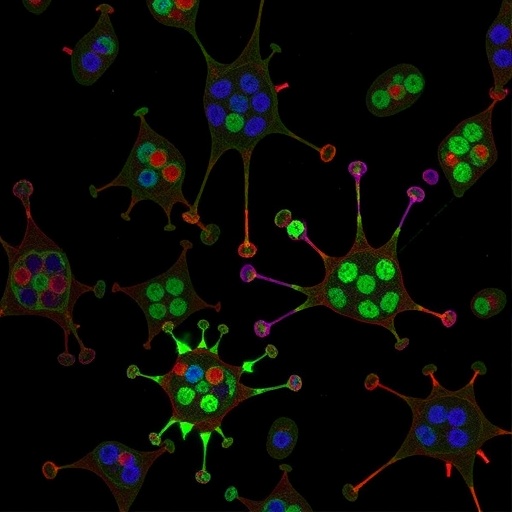In a groundbreaking study published in Nature, researchers have unveiled critical insights into the functional heterogeneity of CD8+ T cells and their fate decisions within tumor-draining lymph nodes (tdLNs). The study addresses a pivotal question in immunology and immunotherapy: Do high-avidity, stem-like CD8+ T cells emerge via selective functional programming, or are they merely a subset defined by spatial niche occupancy? The findings elucidate the role of T cell receptor (TCR) affinity in shaping the PD-1+SLAMF6+ stem-like T cell (TSL) subset, revealing a direct correlation between TCR avidity and inhibitory receptor expression—a phenomenon with profound implications for therapeutic targeting of chronic infections and cancer.
The research team employed H-2Kb–SIINFEKL tetramers to identify OVA-specific CD8+ T cells, allowing for precise measurement of antigen reactivity. Recognizing that tetramer binding intensity can confound interpretations due to variability in surface TCR expression levels, the investigators refined their analysis by normalizing tetramer intensity against CD3 expression, creating an imputed TCR affinity index. This normalization provided a more faithful proxy of TCR functional avidity, allowing comparisons across polyclonal repertoires within individual mice.
Subsequent stratification of OVA-tetramer+ CD8+ T cells into five discrete affinity bins, each representing 20% of the population from the tdLN, revealed a compelling trend. Cells occupying the highest affinity tier consistently exhibited the greatest mean PD-1 expression within the TSL compartment. This sharp correlation suggests that the acquisition of elevated PD-1 expression—a hallmark of stem-like exhausted T cells—is not a random occurrence but rather a feature selectively enriched among T cells with superior TCR affinities.
Further scrutiny of SLAMF6, another co-inhibitory molecule characteristically expressed on these TSL cells, paralleled the expression pattern of PD-1. SLAMF6 levels were markedly higher in the high-affinity TCR bins, underlining a coordinated upregulation of inhibitory receptors in high-avidity antigen-reactive clones. Of particular note, the enhanced CD8 co-receptor expression in SLAMF6+ TSL cells may potentiate this selective binding, as CD8 is known to facilitate TCR interaction with peptide-MHC complexes, thereby augmenting functional avidity.
To control for possible confounding effects of variable CD8 expression, the researchers strategically gated on intermediate CD8-expressing TSL cells, reinforcing the robustness of the PD-1 versus affinity correlation under stringent phenotypic controls. This meticulous approach substantiated that even among subsets with constrained CD8 surface levels, PD-1 expression remained a faithful correlate of TCR avidity.
Expanding beyond the transplantable tumor model, the team validated this correlation in mice immunized with soluble OVA protein, supporting the generalizability of their observations to diverse antigenic contexts. Notably, the positive correlation between inhibitory receptor expression and TCR affinity was localized specifically to the draining lymph node, absent in systemic compartments such as the spleen or non-antigen presenting tissues. This spatial restriction underscores the fundamental influence of antigen exposure and microenvironmental cues in shaping TSL cell fate.
Collectively, these data provide compelling evidence for a selective enrichment of high-affinity clones within the PD-1+SLAMF6+ TSL subset, suggesting that antigen recognition strength is a key determinant of stem-like T cell differentiation. This finding challenges previous models that posited a stochastic or niche-driven process, instead highlighting affinity-based functional programming as a pivotal axis.
From a mechanistic standpoint, the study offers intriguing hints about how inhibitory signaling pathways modulate clonal fitness and exhaustion trajectories. The enrichment of PD-1 and SLAMF6 on high-avidity clones implies a critical balancing act where inhibitory receptors restrain overly vigorous responses, potentially preserving stemness and preventing terminal exhaustion. This dynamic equilibrium could be harnessed therapeutically, for example, by modulating PD-1 signaling to sustain high-avidity T cell pools in chronic infection or cancer.
The translational implications are profound. Immunotherapies, particularly checkpoint blockade treatments, rely heavily on reinvigorating T cells with enduring effector potential. By identifying the TCR affinity landscape that favors stem-like TSL cells, clinicians may refine strategies to selectively expand or preserve these cell subsets. Furthermore, adoptive T cell therapies could be optimized by enriching for high-avidity PD-1+SLAMF6+ T cells, potentially improving efficacy and durability of anti-tumor responses.
Intriguingly, the work also raises questions about the spatial organization of antigen-reactive T cells within lymphoid tissues. The study’s focus on the tdLN reveals that microenvironmental niches exert powerful influences on T cell fate, offering fertile ground for future exploration of how stromal and dendritic cell interactions orchestrate T cell programming.
Overall, this comprehensive analysis advances our understanding of CD8+ T cell biology by linking TCR affinity to the development of an inhibitory receptor-rich stem-like state within antigen-draining lymph nodes. It paves the way toward rational design of next-generation immunotherapies that leverage intrinsic T cell affinity and checkpoint receptor landscapes to maximize therapeutic potential.
The study by Hor and colleagues represents a significant leap in decoding the immunological code underlying effective and durable T cell responses. As the field continues to unravel the interplay between antigen recognition, inhibitory signaling, and cellular differentiation, these findings provide a critical foundation for both basic science and clinical innovation in immuno-oncology and infectious disease.
Subject of Research: The study focuses on the role of T cell receptor (TCR) affinity in determining the stem-like PD-1+SLAMF6+ CD8+ T cell fate within tumor-draining lymph nodes.
Article Title: Inhibitory PD-1 axis maintains high-avidity stem-like CD8+ T cells
Article References:
Hor, J.L., Schrom, E.C., Wong-Rolle, A. et al. Inhibitory PD-1 axis maintains high-avidity stem-like CD8+ T cells. Nature (2025). https://doi.org/10.1038/s41586-025-09440-x




